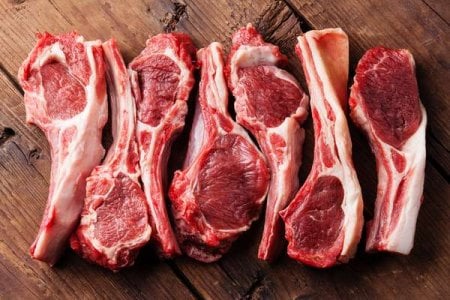Aussies in for delayed lamb price slump in groceries, industry group says
If you've been thinking about heading to your local supermarket to score a pack of lamb cutlets for your barbecue, you might consider waiting.
While lamb prices have been falling in sale yards around the country, it has been reported that this is yet to result in lower prices in the grocery.
According to figures from Meat and Livestock Australia (MLA), some sheep and lamb categories have dropped by 70 per cent in the sale yards in the last twelve months.
The prices had been coming down for months, but in the past couple of weeks, they have fallen to levels unseen in a few years.
Unfortunately, this downturn has impacted the profit of sheep producers—providing a sharp contrast to record lamb and mutton prices less than three years ago.
Despite this change, however, the lamb prices at the supermarket hadn’t caught up. New data revealed that the prices at the grocery or butcher have only dropped by 7 per cent.
According to Steve Bignall from MLA, when this kind of market downturn happened before, it took a while before the prices flowed completely to the supermarket shelf.
‘There have been two data points, back in 2012 and 2016, where lower livestock prices did flow through to lower retail prices and, on both those occasions, it took on average eight months to flow through,’ he said.
He added: ‘When they did drop, those low prices at a retail level stayed down for around nine months.’
It was reported that Australians have eaten more lamb in the past twelve months than in four years. With the prices expected to go down, Mr Bignall believed that the consumption would continue.
‘We can see that over 190,000 tonnes of lamb meat were consumed in Australia last year, which was the highest since 2018,’ he explained.
The news comes as peak sheep farmer bodies prepare for a crisis meeting. They will be discussing possible ways to help producers suffering through a rapid fall in prices and looming dry conditions.
Steve Harrison, President of Wool Producers Australia, stated that they were advocating shire rate subsidies and a pause or reduction to the compulsory farmer levies.
‘We've certainly got to look at something because the current (prices) for sheep and lambs are pretty abysmal,’ he claimed.
While reduced lamb prices are favourable to consumers, it is less ideal for producers. They would like better prices at the farm gate, but with factors like dry weather and oversupply of sheep, the prices had fallen to as low as $2 a head.
In some cases, sheep had been returned to the farm because they weren’t bought.
Due to this, some farmers are taking matters into their own hands and selling directly to consumers online.
Case in point: George Beck, a farmer who runs prime lambs on his property in Pleasant Park in South Australia, sold his lambs directly to consumers to avoid low sale yard prices.
‘We had some good lambs that were left over…we'd planned to put them into the market hoping it would correct itself, but it's continued to slide,’ he said.
Selling boxed whole lamb of half-lambs to his local football and netball club, Mr Beck admitted that he would not be making a large profit on the sales. However, the community is pleased to make the purchase directly.
‘It was sort of a short-term win situation for everyone and a bit of a cost-recovery exercise for us,’ he claimed.
While he is not planning on selling directly in the long term, Mr Beck keeps an open mind: ‘If the market's going to be tough for 12 or 18 months, it could be another little side outlet for us to siphon some of the better-quality lambs off.’
Another savvy farmer had devised an online sales concept to reduce marketing and transport costs.
Rob Fraser, a farmer from Southern Tablelands of New South Wales, launched Abblamb—an online marketing platform that gave a dollars-per-head price on lambs before they left the farm.
‘I felt lamb producers needed a platform where marketing costs can be reduced,’ Mr Fraser said.
‘We can be more of a price-maker, not taker…because it costs so much to pass them in and bring them home. With this system, we can pass them in, open the gate, and they're still here to market another day. We haven't lost money until we sell them,’ he explained.

While we hope for cheaper lamb prices to hit supermarkets soon, we also wish problems faced by the livestock industry are solved for the benefit of Aussie farmers.
What do you think of this story, members? Share your thoughts in the comments below!
While lamb prices have been falling in sale yards around the country, it has been reported that this is yet to result in lower prices in the grocery.
According to figures from Meat and Livestock Australia (MLA), some sheep and lamb categories have dropped by 70 per cent in the sale yards in the last twelve months.
The prices had been coming down for months, but in the past couple of weeks, they have fallen to levels unseen in a few years.
Unfortunately, this downturn has impacted the profit of sheep producers—providing a sharp contrast to record lamb and mutton prices less than three years ago.
Despite this change, however, the lamb prices at the supermarket hadn’t caught up. New data revealed that the prices at the grocery or butcher have only dropped by 7 per cent.
According to Steve Bignall from MLA, when this kind of market downturn happened before, it took a while before the prices flowed completely to the supermarket shelf.
‘There have been two data points, back in 2012 and 2016, where lower livestock prices did flow through to lower retail prices and, on both those occasions, it took on average eight months to flow through,’ he said.
He added: ‘When they did drop, those low prices at a retail level stayed down for around nine months.’
It was reported that Australians have eaten more lamb in the past twelve months than in four years. With the prices expected to go down, Mr Bignall believed that the consumption would continue.
‘We can see that over 190,000 tonnes of lamb meat were consumed in Australia last year, which was the highest since 2018,’ he explained.
The news comes as peak sheep farmer bodies prepare for a crisis meeting. They will be discussing possible ways to help producers suffering through a rapid fall in prices and looming dry conditions.
Steve Harrison, President of Wool Producers Australia, stated that they were advocating shire rate subsidies and a pause or reduction to the compulsory farmer levies.
‘We've certainly got to look at something because the current (prices) for sheep and lambs are pretty abysmal,’ he claimed.
While reduced lamb prices are favourable to consumers, it is less ideal for producers. They would like better prices at the farm gate, but with factors like dry weather and oversupply of sheep, the prices had fallen to as low as $2 a head.
In some cases, sheep had been returned to the farm because they weren’t bought.
Due to this, some farmers are taking matters into their own hands and selling directly to consumers online.
Case in point: George Beck, a farmer who runs prime lambs on his property in Pleasant Park in South Australia, sold his lambs directly to consumers to avoid low sale yard prices.
‘We had some good lambs that were left over…we'd planned to put them into the market hoping it would correct itself, but it's continued to slide,’ he said.
Selling boxed whole lamb of half-lambs to his local football and netball club, Mr Beck admitted that he would not be making a large profit on the sales. However, the community is pleased to make the purchase directly.
‘It was sort of a short-term win situation for everyone and a bit of a cost-recovery exercise for us,’ he claimed.
While he is not planning on selling directly in the long term, Mr Beck keeps an open mind: ‘If the market's going to be tough for 12 or 18 months, it could be another little side outlet for us to siphon some of the better-quality lambs off.’
Another savvy farmer had devised an online sales concept to reduce marketing and transport costs.
Rob Fraser, a farmer from Southern Tablelands of New South Wales, launched Abblamb—an online marketing platform that gave a dollars-per-head price on lambs before they left the farm.
‘I felt lamb producers needed a platform where marketing costs can be reduced,’ Mr Fraser said.
‘We can be more of a price-maker, not taker…because it costs so much to pass them in and bring them home. With this system, we can pass them in, open the gate, and they're still here to market another day. We haven't lost money until we sell them,’ he explained.
Key Takeaways
- Lamb prices have been falling in farms across Australia, but there is a lag before these price changes are seen in supermarkets.
- Industry body Meat and Livestock Australia anticipates that it could take up to eight months for consumers to see the full effect of the price slump in their local supermarkets.
- Sheep farmers, affected by a decrease in market prices and adverse conditions, are opting to sell meat directly to consumers to try and improve returns.
- Some farmers have shifted their strategies, selling lamb directly to the public online to help navigate the drop in prices and oversupply of sheep.
While we hope for cheaper lamb prices to hit supermarkets soon, we also wish problems faced by the livestock industry are solved for the benefit of Aussie farmers.
What do you think of this story, members? Share your thoughts in the comments below!








